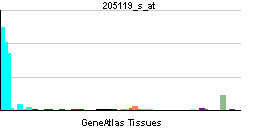Formyl peptide receptor 1
| Formyl peptide receptor 1 | |||||||||||
|---|---|---|---|---|---|---|---|---|---|---|---|
| Identifiers | |||||||||||
| Symbols | FPR1 ; FMLP; FPR | ||||||||||
| External IDs | Template:OMIM5 Template:MGI HomoloGene: 20466 | ||||||||||
| |||||||||||
| RNA expression pattern | |||||||||||
 | |||||||||||
 | |||||||||||
| More reference expression data | |||||||||||
| Orthologs | |||||||||||
| Template:GNF Ortholog box | |||||||||||
| Species | Human | Mouse | |||||||||
| Entrez | n/a | n/a | |||||||||
| Ensembl | n/a | n/a | |||||||||
| UniProt | n/a | n/a | |||||||||
| RefSeq (mRNA) | n/a | n/a | |||||||||
| RefSeq (protein) | n/a | n/a | |||||||||
| Location (UCSC) | n/a | n/a | |||||||||
| PubMed search | n/a | n/a | |||||||||
Formyl peptide receptor 1, also known as FPR1, is a human gene.[1]
See also
References
Further reading
- Graves V, Gabig T, McCarthy L; et al. (1992). "Simultaneous mobilization of Mac-1 (CD11b/CD18) and formyl peptide chemoattractant receptors in human neutrophils". Blood. 80 (3): 776–87. PMID 1322204.
- Murphy PM, Ozçelik T, Kenney RT; et al. (1992). "A structural homologue of the N-formyl peptide receptor. Characterization and chromosome mapping of a peptide chemoattractant receptor family". J. Biol. Chem. 267 (11): 7637–43. PMID 1373134.
- Perez HD, Holmes R, Kelly E; et al. (1992). "Cloning of the gene coding for a human receptor for formyl peptides. Characterization of a promoter region and evidence for polymorphic expression". Biochemistry. 31 (46): 11595–9. PMID 1445895.
- Bao L, Gerard NP, Eddy RL; et al. (1992). "Mapping of genes for the human C5a receptor (C5AR), human FMLP receptor (FPR), and two FMLP receptor homologue orphan receptors (FPRH1, FPRH2) to chromosome 19". Genomics. 13 (2): 437–40. PMID 1612600.
- Murphy PM, McDermott D (1991). "Functional expression of the human formyl peptide receptor in Xenopus oocytes requires a complementary human factor". J. Biol. Chem. 266 (19): 12560–7. PMID 1712023.
- Boulay F, Tardif M, Brouchon L, Vignais P (1990). "Synthesis and use of a novel N-formyl peptide derivative to isolate a human N-formyl peptide receptor cDNA". Biochem. Biophys. Res. Commun. 168 (3): 1103–9. PMID 2161213.
- Boulay F, Tardif M, Brouchon L, Vignais P (1991). "The human N-formylpeptide receptor. Characterization of two cDNA isolates and evidence for a new subfamily of G-protein-coupled receptors". Biochemistry. 29 (50): 11123–33. PMID 2176894.
- Wahl SM, Allen JB, Gartner S; et al. (1989). "HIV-1 and its envelope glycoprotein down-regulate chemotactic ligand receptors and chemotactic function of peripheral blood monocytes". J. Immunol. 142 (10): 3553–9. PMID 2541200.
- Jesaitis AJ, Naemura JR, Painter RG; et al. (1983). "Intracellular localization of N-formyl chemotactic receptor and Mg2+ dependent ATPase in human granulocytes". Biochim. Biophys. Acta. 719 (3): 556–68. PMID 6129903.
- Prossnitz ER, Kim CM, Benovic JL, Ye RD (1995). "Phosphorylation of the N-formyl peptide receptor carboxyl terminus by the G protein-coupled receptor kinase, GRK2". J. Biol. Chem. 270 (3): 1130–7. PMID 7836371.
- Klotz KN, Jesaitis AJ (1994). "Physical coupling of N-formyl peptide chemoattractant receptors to G protein is unaffected by desensitization". Biochem. Pharmacol. 48 (6): 1297–300. PMID 7945424.
- Bommakanti RK, Dratz EA, Siemsen DW, Jesaitis AJ (1994). "Characterization of complex formation between Gi2 and octyl glucoside solubilized neutrophil N-formyl peptide chemoattractant receptor by sedimentation velocity". Biochim. Biophys. Acta. 1209 (1): 69–76. PMID 7947984.
- Murphy PM, Tiffany HL, McDermott D, Ahuja SK (1993). "Sequence and organization of the human N-formyl peptide receptor-encoding gene". Gene. 133 (2): 285–90. PMID 8224916.
- Jesaitis AJ, Erickson RW, Klotz KN; et al. (1993). "Functional molecular complexes of human N-formyl chemoattractant receptors and actin". J. Immunol. 151 (10): 5653–65. PMID 8228254.
- Särndahl E, Bokoch GM, Boulay F; et al. (1996). "Direct or C5a-induced activation of heterotrimeric Gi2 proteins in human neutrophils is associated with interaction between formyl peptide receptors and the cytoskeleton". J. Biol. Chem. 271 (25): 15267–71. PMID 8663057.
- Maestes DC, Potter RM, Prossnitz ER (1999). "Differential phosphorylation paradigms dictate desensitization and internalization of the N-formyl peptide receptor". J. Biol. Chem. 274 (42): 29791–5. PMID 10514456.
- Liang TS, Wang JM, Murphy PM, Gao JL (2000). "Serum amyloid A is a chemotactic agonist at FPR2, a low-affinity N-formylpeptide receptor on mouse neutrophils". Biochem. Biophys. Res. Commun. 270 (2): 331–5. doi:10.1006/bbrc.2000.2416. PMID 10753626.
- Luu NT, Rainger GE, Nash GB (2000). "Differential ability of exogenous chemotactic agents to disrupt transendothelial migration of flowing neutrophils". J. Immunol. 164 (11): 5961–9. PMID 10820279.
- Bennett TA, Maestas DC, Prossnitz ER (2000). "Arrestin binding to the G protein-coupled N-formyl peptide receptor is regulated by the conserved "DRY" sequence". J. Biol. Chem. 275 (32): 24590–4. doi:10.1074/jbc.C000314200. PMID 10823817.
- Ayala JM, Goyal S, Liverton NJ; et al. (2000). "Serum-induced monocyte differentiation and monocyte chemotaxis are regulated by the p38 MAP kinase signal transduction pathway". J. Leukoc. Biol. 67 (6): 869–75. PMID 10857861.
| Stub icon | This membrane protein–related article is a stub. You can help Wikipedia by expanding it. |
This article incorporates text from the United States National Library of Medicine, which is in the public domain.